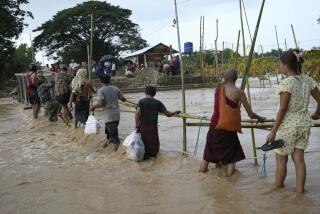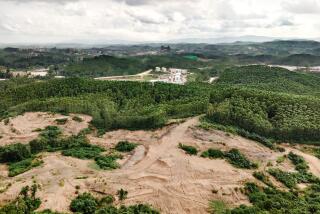Tsunami Death Toll Hits 60,000
BANDA ACEH, Indonesia — Exhausted survivors of southern Asia’s giant earthquake and tsunami combed the rubble for food and belongings Tuesday as officials stepped up efforts to identify and bury the dead, whose numbers topped 60,000.
Small shipments of food, medicine, clothing and bedding, some sent by governments and others organized by individuals, reached a few areas in Indonesia, Sri Lanka, India and Thailand, the countries most seriously affected. Indonesia reported more than 32,000 dead, followed by Sri Lanka with about 22,000.
In the Indonesian provincial capital of Banda Aceh, the nearest major city to the epicenter of the quake, decaying and bloated bodies were still strewn throughout the streets early today, the third day since the disaster. More than 75 blackened corpses cast an overpowering stench over Panglima Polem Street, and authorities appeared unprepared to organize even the most basic services for disaster victims.
Indonesian President Susilo Bambang Yudhoyono, who visited Banda Aceh on Tuesday, called the tsunami a “national catastrophe” and sought to assure residents that the government was doing what it could to help them.
“We will bury all the dead within two days,” he said.
Thousands who survived found shelter in tents along busy streets and in city parks; many returned Tuesday to the muddy remnants of their homes to salvage what they could. Gasoline was in such short supply that ambulances were being issued barely a gallon a day.
Authorities have been unable to send assistance to Meulaboh, the coastal region south of Banda Aceh where as many as 5,000 may have died. Officials said that at least 75% of the buildings in Meulaboh were destroyed by the quake and tsunami.
Roads to the area, which has a population estimated at 100,000, were reported to be impassable.
With aid only starting to arrive, desperate people in Meulaboh and other towns were stealing whatever food they could find.
“People are looting, but not because they are evil, but they are hungry,” Red Cross official Irman Rachmat in Banda Aceh told Associated Press.
In the neighborhoods around Panglima Polem Street, once a thriving shopping and residential area, whole blocks were little more than rubble. Boats were perched at odd angles in streets or atop piles of broken concrete and timber where houses once stood.
Television sets, mattresses, clothes, plastic bins, motorbikes, upended cars and dead animals were among the stinking debris. Survivors covered their faces with scarves or towels as they walked by.
A few residents told of miraculous escapes, but even those were tinged with sadness.
Sudirman, a 55-year-old fisherman, who like many Indonesians uses only one name, was in his apartment on Panglima Polem when the magnitude 9 earthquake hit. When a second tremor struck moments later, he and his family hurried to the street.
They heard people shout that water was coming and looked up to see a wave at least 10 feet tall rushing toward them. He and his family began running but were swept up by the wave.
The swirling water carried Sudirman down the street, he said, periodically bringing him to the surface and allowing him to take a gulp of air. He was bashed in the head and legs by pieces of wood. After 100 yards, he was pushed into a side street and escaped the wave.
“I almost gave up. I almost died,” he said. “I was lucky.”
His son, Suwarno, was carried 200 yards by the wave and also escaped. But five family members were lost, including Suwarno’s wife and three of their children, ages 2, 5 and 11.
During the family’s salvage effort, Suwarno, 38, emerged from their apartment with a photo of his wife and children and broke into tears as he showed it to visitors. Then he walked two blocks to where his wife’s body lay. Family members had wrapped the body in a cloth. Suwarno pinned a piece of paper to it so she could be identified when the body was picked up.
Health officials worry that cholera and other diseases could break out if water sources are contaminated. But some survivors said the local authorities were too preoccupied with their own tragedies to do their job.
“The local government got hit by the disaster and everyone is taking care of their own family,” said Muslim, 45, who lost 10 relatives — his mother, a brother, two sisters and six nephews.
President Yudhoyono said hundreds of police and soldiers were among the dead, including some who died trying to save others. Officials said the loss of so many troops and police had slowed the emergency response.
Banda Aceh residents were clamoring for help.
“Where is the assistance? There is nothing. All the government are asleep,” a man named Mirza, 28, told Associated Press.
It was unclear how the disaster and aid efforts would affect Aceh residents’ feelings about the Indonesian government, which for 28 years has been trying to put down a rebellion by separatists who contend that Indonesia never legally annexed the province. Aceh has been under strict military control for 18 months and few foreigners have been allowed into the province.
Some question whether aid has been delayed by the military’s strong grip on the province and its reluctance to open the region to outsiders. But Aceh rebels declared a cease-fire in an effort to speed delivery of assistance to the area, and the government has allowed some international officials to enter.
The devastation in other nations was equally horrendous. The death toll in Sri Lanka neared 22,000 early today, but many remote areas had not been fully assessed.
Among the dead were an estimated 1,000 people who were killed when the tsunami washed over a train near the town of Hikkaduwa on Sri Lanka’s southwestern coast. The train, dubbed Queen of the Sea, was swept off the track by the force of the water. Many of the dead were frightened villagers who had tried to climb aboard the train to escape the wave, police said.
Sri Lankan President Chandrika Kumaratunga appealed for international aid, as did the rebel Tamil Tigers, who occupy the northern part of the country and have been fighting for an independent homeland for their ethnic group for more than two decades.
An estimated 1 million of Sri Lanka’s 20 million people have been left homeless. Aid workers said there were 335 refugee camps in Sri Lanka ranging in size from 500 to 7,000 people, most housed in churches, Buddhist temples and community centers. A heavy rain Tuesday added further misery for survivors sleeping out in the open.
As in other countries, a pressing issue was how to dispose of the thousands of bodies. Aid workers said they expected to find many corpses entombed in vehicles buried in sand.
“At one point, they have to surface, and it won’t be a pretty sight,” said Sithmini Perera, Colombo-based communications director with World Vision, a civic group. “There’s also a cry for more petroleum to burn the bodies.”
Tourists caught when their holiday turned into a nightmare continued to trickle out of isolated areas, fighting through traffic jams and congested airports to leave the country.
One was Alexander Van Boetzelaer, a Dutch tourist who decided to splurge last week and stay at a relatively expensive resort in Tanglee that was away from the beach and had cement structures rather than the flimsy wooden bungalows found in other hotels in the coastal town of Galle.
It proved a lifesaving decision. About 9 a.m. Sunday, many in his group of 10 European tourists were having breakfast when they heard a boom that sounded “like two helicopters descending on them,” he said.
The first wave of water was relatively small — about 18 inches — but very fast. Then a few minutes later, a 30-foot wall of water reared up. Boetzelaer and others in the group raced for a nearby stairway. Most made it, but a few didn’t.
“One Norwegian couple, the wife was all right but the son and husband got swept away,” he said. “Another couple survived, but their 7-year-old daughter is gone. It was especially bad for kids who weren’t strong swimmers or able to grab trees.”
There were stories of sheer luck.
Jerome Kerr-Jarrett, 25, a British tourist, was in a cabana in Galle when the waves hit. The structure broke up and he was swept out to sea, but the wave brought him back to almost the same spot. He was able to grab a tree until the water receded.
“I was absolutely exhausted,” he said. “It’s still hard to believe this has happened.”
Many people in and around Galle were sitting in the ruins of their homes Tuesday tending open fires because they had nowhere else to go. Along several stretches, a thicket of fishing and pleasure boats was strewn along the road. A graveyard just outside Galle looked like it had been plowed up, while vast stretches of residential and commercial buildings were flattened.
Several communities remained cut off, served by little more than the odd helicopter drop of supplies. Sri Lanka has few aircraft and almost all of them are controlled by the military. Brig. Gen. Daya Ratnayake said 10 helicopters and 25,000 troops were rushed into service to help inaccessible areas.
“It is a national disaster and the army is responding,” he said.
In India, the Home Ministry said more than 7,000 deaths had been confirmed but estimates of the final toll went as high as 12,000. The country’s main cable television station said 8,000 people were missing and possibly dead in India’s remote Andaman and Nicobar islands, just north of Sumatra.
And in the once-thriving resort towns of southern Thailand, volunteers pulled corpses from beaches and debris that had once been resorts. More than 1,500 died there, about half of them tourists visiting Thailand over the Christmas holidays.
In Phuket, a 2-year-old boy who was found sitting by himself along the side of a road and was taken to a local hospital was reunited with his relatives. His uncle located him after seeing news of the toddler on the Internet. The boy’s father was discovered at another hospital. But his mother was missing.
Merete Vanebo, a 37-year-old Norwegian who has worked for a diving tour company in the Thai town of Khao Lak for the last three years, was in the bathroom of her beachfront apartment when the water started pouring in, overturning furniture.
“Your first instinct is, ‘Oh, I’ll swim for it,’ ” she recalled while waiting for a plane to take her back to Norway. “But the water was dark brown, all muddy, and there’s just no way you can ride the water. I just kept telling myself: ‘Swim, swim.’
“But swimming had nothing to do with it. I was just lucky. Pure luck.”
Vanebo, who escaped with bruised legs and arms, said it was 36 hours before Thai authorities brought buses in to evacuate survivors from Khao Lak. During that time, there was no clean water, no electricity and no food, she said.
“There were children wandering around who had lost both parents — just while they were eating breakfast,” she said. By the time the evacuation began, looters were scavenging.
Before leaving, Vanebo returned to collect what was left of her clothing and other possessions.
“I found my dive watch,” she said. “It was on the bathroom floor, and it had recorded what it thought was my last dive: 1.8 meters depth for six minutes. That’s how high the water was in my bathroom: 1.8 meters.”
*
Times staff writers Bruce Wallace in Phuket, Thailand, and Paul Watson in Nagappattinam, India, contributed to this report.
More to Read
Sign up for Essential California
The most important California stories and recommendations in your inbox every morning.
You may occasionally receive promotional content from the Los Angeles Times.










